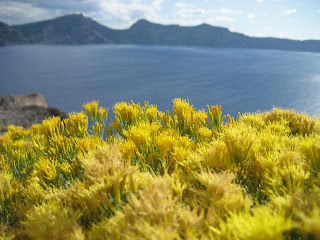



Your first views of Mount Rainier are awe-inspiring, to say the least. You can see it from the forest-lined road towering on the horizon. David and I thought the drive was one of the prettiest we’d been on thus far. We came in to the park on the east side, like we did at Glacier National Park, and had picked out a campground at White River. It was already pretty filled on a Thursday, but we found a site next to the community campfire ring. The only downside to that is you’re asked to attend the nightly lectures given by the park rangers, because you’re in close proximity. (We did do this the first night and found it quite interesting…)We had terrific “neighbors” at the site next door—two sisters who try and get together for an annual campout. Barbara and Betty Lou were charming and very helpful in providing good advice on the parks we were planning to visit. This “insider information” is like mining for gold. We have found the camaraderie that exists among fellow campers can impart wisdom on so many levels, David and I strike up conversations with strangers as frequently as we can. Hiking is the premier activity and we jumped right in on our first morning there. David was what I call affectionately the “trail boss,” so he chose the trail. What a mistake (And I might add it was a short-lived title) after I found myself huffing and puffing up a steep mountainside. I lamented the fact that it seemed the trail should have been labeled strenuous not moderate and David turned to me and said “Oh, didn’t I tell you? It is!” Of course when you’re 6,000-plus feet up, it’s difficult to throw too much of a tantrum…However, it was a breathtaking view and well worth it, so I didn’t stay mad for long. We climbed all the way to a ranger fire lookout built sometime in the 1920’s. On our way down we came across an amazing sight. A herd of mountain goats were frolicking in a valley just below us. I laughed and told David “that there was something wrong with this picture—usually WE are looking up at the goats, not the other way around!” The next day was rainy and we were pretty tired from our climb so we opted to drive around the park and do sightseeing. Many of the buildings are very well-maintained and a few were part of the original settlement before the land became a park. We did get a chance to do a short hike through an old growth forest that was spectacular. I found it very spiritual; as I walked into this grove of tall majestic trees, it seemed as though they were transformed into the pillars of an outdoor temple, pillars that prompted you to look heavenward. Pictures just don’t seem to do this park justice, unfortunately. After seeing various sights, hiking and getting much-needed gas, we returned to the campground and socialized with “the girls” as David called them. Barbara and Betty Lou were just delightful and continued to add to our growing conviction that you do indeed meet the nicest people when you’re camping in the national park system.
David's Perspective:Mt. Rainier was far more majestic than I had expected. After having been at Glacier I was surprised that the largest glaciers are in fact on Mt. Rainier . At 14,000 + feet it’s one of the three largest in the lower 48 with the others being Shasta in Northern California and Whitney in Southern California, both also somewhat over 14,000 feet. The forests around the mountain were absolutely beautiful. Again, every time we go to a new park, the experience is quite amazing as each one seems to somehow top the last. I could have stayed at Rainier for several weeks and never been bored with the beauty and grandeur of this place. I think one could live going from one park to the next and spending the 14 days allowed and then moving on. My cost as a senior is half-price, so Mt Rainier was $8 a day to park in one of the most unique and beautiful spots on earth. I would say not a bad deal!




































